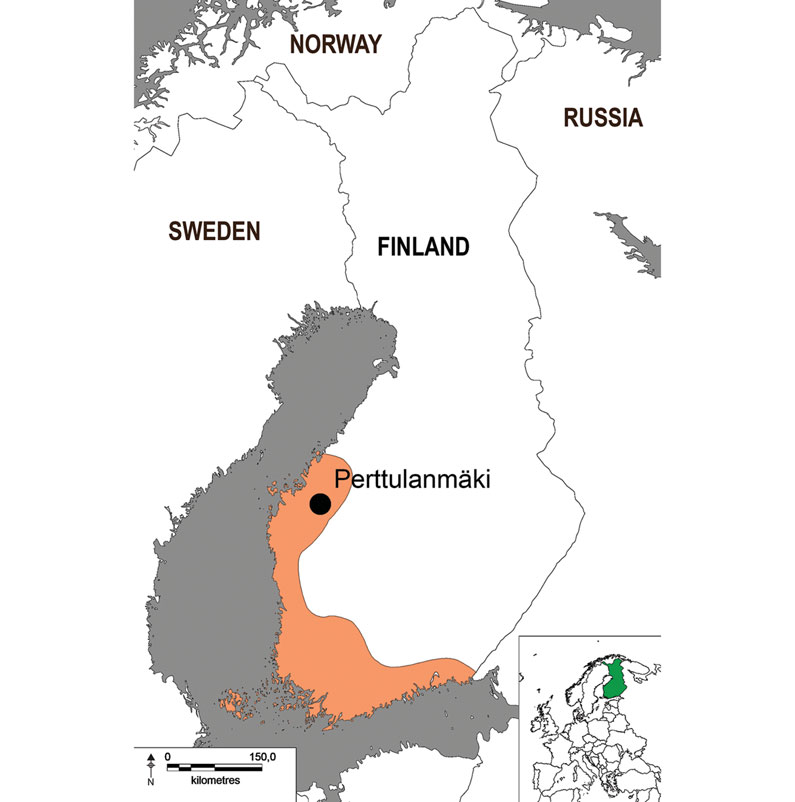On the scent of an animal skin: new evidence on Corded Ware mortuary practices in Northern Europe, Antiquity (2018) 92(361):118-131.
Abstract (emphasis mine):
The Late Neolithic Corded Ware Culture (c. 2800–2300 BC) of Northern Europe is characterised by specific sets of grave goods and mortuary practices, but the organic components of these grave sets are poorly represented in the archaeological record. New microscopic analyses of soil samples collected during the 1930s from the Perttulanmäki grave in western Finland have, however, revealed preserved Neolithic animal hairs. Despite mineralisation, the species of animal has been successfully identified and offers the oldest evidence for domestic goat in Neolithic Finland, indicating a pastoral herding economy. The mortuary context of the goat hair also suggests that animals played a significant role in the Corded Ware belief system.
Excerpts:
Although the material culture used in Corded Ware funerary rituals is well known, a full appreciation of the associated mortuary practices is still lacking. In fact, even though evidence for internal wooden and stone structures is commonly documented in Corded Ware mortuary contexts (e.g. Fischer 1956; Malmer 1962; Hansen 1994; Vander Linden 2007), detailed information on the ways that structures within the grave might have been furnished is largely missing. The use of textiles, mats and furs to cover grave pit walls and floors is commonly documented in Yamnaya Culture graves (Heyd 2011). This culture represents the best-known proxy for the incoming gene-flow that occurred in Europe during the third millennium BC, resulting in the formation of the Corded Ware phenomenon (Allentoft et al. 2015; Haak et al. 2015; Kristiansen et al. 2017). Similar practices may, therefore, have occurred in the Corded Ware tradition. In fact, the Corded Ware graves already show strong affinities to the Yamnaya burial rituals; for example, in the practice of a single inhumation under a barrow (Kristiansen et al. 2017: 336). New information on Corded Ware mortuary practices has come from the northern periphery of the cultural area. The results are based on microscopic analyses conducted on soil samples collected from the Perttulanmäki Corded Ware grave in western Finland (Figure 1). These analyses suggest that a goat skin had been placed in the grave. This discovery is important as it provides clear evidence of a mortuary practice that has only in rare cases been previously suspected (e.g. Torvinen 1979; Meurkens et al. 2015).

orange. Map: K. Vajanto.
The animal accompaniment could be present in various forms. Several Corded Ware burials in the Baltic area have been furnished with artefacts made of domestic animal bone (Zagorska 2006: 103; Lõugas et al. 2007: 25–26; Larsson 2009: 63). That all milk residues from Finnish Corded Ware pottery were found exclusively in beakertype ‘drinking’ vessels (Cramp et al. 2014: 4) further supports this idea. These beakers are usually found in grave deposits (Edgren 1970: 76–77; Larsson 2009: 352), so the animal could have also been represented by placing milk, or a vessel connected with milk, in the grave (Edgren 1970: 76–77; Larsson 2009: 352). This being said, it must be noted that, due to the vast distribution area of the Corded Ware phenomenon, the same objects or symbols might not have been connected with the same ideas (Furholt 2014: 82). Moreover, some prehistoric societies might have also repeated the ritual practice simply as tradition—after its original meaning had been forgotten (Nilsson Stutz 2003: 319).
Interesting indeed regarding the culture behind Corded Ware herders in the Baltic Sea (quite likely speakers of Uralic languages) but also formally the emphasis on Yamna as a proxy population for Corded Ware migrants (which we had already seen in geneticists answering to criticism).
Interesting also how an article about the Corded Ware culture selects Volker Heyd – an expert in Yamna migration and in the Yamna -> Bell Beaker migration, who rejects a relationship between Yamna and Corded Ware migrants, and between Corded Ware and Bell Beaker peoples – over Kristiansen and his IE-CWC research group, who are supposedly the fashionable experts in CWC right now for certain amateur geneticists…
It would seem as if academic pressure is making the hype around (the wrong interpretations of) the 2015 papers (and the group behind them) fade…
See also:
- Corded Ware culture contacts in the Baltic Sea region linked to immigrant potters
- The concept of “Outlier” in Human Ancestry (III): Late Neolithic samples from the Baltic region and origins of the Corded Ware culture
- Genetic prehistory of the Baltic Sea region and Y-DNA: Corded Ware and R1a-Z645, Bronze Age and N1c
- Science and Archaeology (Humanities): collaboration or confrontation?
- Massive Migrations? The Impact of Recent aDNA Studies on our View of Third Millennium Europe
- Another hint at the role of Corded Ware peoples in spreading Uralic languages into north-eastern Europe, found in mtDNA analysis of the Finnish population
- Recent archaeological finds near Indo-European and Uralic homelands
- New Ukraine Eneolithic sample from late Sredni Stog, near homeland of the Corded Ware culture